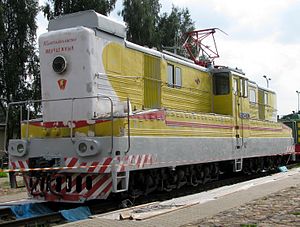SŽD series ВЛ26
| SŽD series ВЛ26 (WL26) | |
|---|---|
|
ВЛ26.005
|
|
| Numbering: | SŽD ВЛ26.001-010 |
| Number: | 10 |
| Manufacturer: | Dnipropetrovsk electric locomotive factory |
| Year of construction (s): | 1966-1967 |
| Retirement: | 1980s |
| Axis formula : | Co'Co ' |
| Gauge : | 1,520 mm |
| Length over buffers: | 19,900 mm |
| Trunnion Distance: | 10,000 mm |
| Bogie axle base: | 3,900 mm |
| Total wheelbase: | 13,900 mm |
| Service mass: | 126 t |
| Wheel set mass : | 21 t |
| Top speed: | 80 km / h |
| Hourly output : | 1,410 kW |
| Continuous output : | 1,080 kW |
| Driving wheel diameter: | 1,050 mm |
| Power system : | 3 kV = accumulator |
| Number of traction motors: | 6th |
The SŽD series ВЛ26 (German transcription WL 26 ) of the Soviet Railways (SŽD) was a six-axle electric locomotive for operation on main lines with direct current . They were developed as a result of operating experience with the SŽD series ВЛ41 and were used for shunting services on stations with non-electrified tracks. They were delivered by the Dnepropetrovsk electric locomotive factory from 1966 to 1967 .
history
The contact wire / accumulator electric locomotive was developed with the aim of replacing shunting diesel locomotives for shunting work on electrified railway stations.
The accumulators made it possible to use the electric shunting locomotives on side tracks of railway stations that were not covered with contact wire. The contact wire / accumulator electric locomotive thus greatly reduced the noise in comparison with the diesel locomotives and did not pollute the atmosphere. This was of particular importance for shunting work in urban areas.
In 1964, engineers of the Baltic railroad developed a sketch project for a contact wire / accumulator electric locomotive for operation on lines with direct current and a voltage of 3 kV. In 1966 four test locomotives of the new series were delivered, they were given the designation ВЛ26 . The locomotives were built by the Dnipropetrovsk electric locomotive factory . In 1967 the plant delivered six locomotives of this series.
The new locomotives were put on the railways in the Baltic States , on railways in Dnipropetrovsk Oblast , Zaporizhia Oblast , the Sverdlovskaya zhelesnaja doroga and also on sidings on some larger industrial plants.
construction
The electric locomotive had a metal box structure, with the driver's cab in the middle. In the lower part of the side porches, the sections of the accumulator battery were arranged, which were charged under the contact wire during work. There were on the electric locomotive six traction electric traction motors of the type ДТ-7А ( DT-7A accommodated), these have been based on the electric traction motors of electric trains in turn ЭР22 created, driving the axles on one side by means of the axle-suspended drive on. In terms of control, a series connection as well as a series - parallel connection could be carried out on the electric locomotive . The series connection was used when operating the accumulator battery of the type РТ-113 ( PT-113 ). This had 672 elements. When operating under the contact wire (without a rechargeable battery), this circuit was not possible, as this could create impermissible voltages on the locomotive's power switch. When operated under contact wire, the accumulators were charged via automatic connections, which resulted in significant losses in electrical energy (approx. 2/3 of the energy consumed). The energy of the charged battery was enough for about an hour of driving.
Results of the review and modernization
The locomotive with the inventory number 005 carried out the power-energy check in 1967 when working in the shunting and pushing service as well as when working on the discharge mountain . The results showed some shortcomings that precluded further procurement of the locomotives. These were:
- The small number of speed steps led to jerky acceleration when starting
- When the locomotive was used on the drainage hill , there was great warming, which resulted in a high loss of energy. This was due to the great internal resistance of the battery
- If the locomotive drove in battery mode in the hourly power regime, the speed was only 12 km / h, which was significantly lower than the projected speed
- The practice of charging the accumulator battery when working with large currents led to the locomotive overheating. They also did not have a loading control, what could under catenary-free sections lead to shutdowns, and it was here for boiling the electrolyte come
In 1972 the locomotive with the inventory number 002 was redesigned in the manufacturer's plant and was given the designation ВЛ26 M .002 . The greatest weakness of the locomotives, energy losses during the automatic charging of the accumulators, was countered by using a thyristor control with wide pulse converters. The locomotive also received equipment for a resistance brake . The battery was replaced by a new one with a higher voltage of the type MT-8 from SAFT from France .
Other locomotives of the series also received a different accumulator battery. Batteries of the type ТНЖ-400 ( TNSCH-400 ) with 840 elements were used. A series connection of four drive motors was used to increase the driving speed .
Fate of the Locomotives
In the 1980s the majority of locomotives were retired and removed from the SŽD's inventory lists. The only known locomotive that has survived is the ВЛ26.005 , which is in the Museum of the Latvian Railway Company in Riga .
See also
Web links
- Website about the ВЛ26 series locomotives
- Photo of the surviving ВЛ26.005 in the Riga Railway Museum
